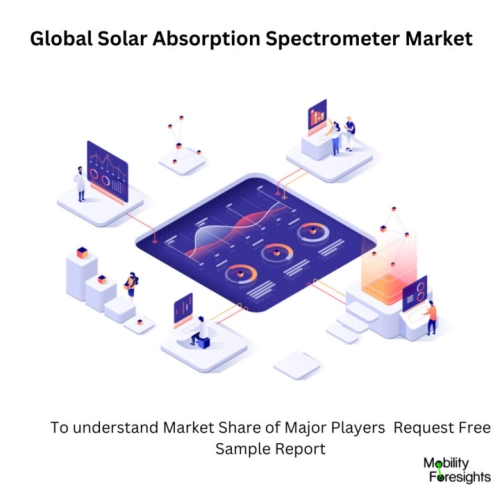
- Get in Touch with Us

Last Updated: Apr 25, 2025 | Study Period: 2023-2030
INTRODUCTION
The Solar Absorption Spectrometer (SAS) is an instrument used to measure the absorption spectra of sunlight by various materials. It is commonly used for the characterization of solar cells and other photovoltaic materials. It is also used to measure the reflectance and transmission of materials such as glass, plastic and thin films.
The SAS consists of a light source, a spectrometer with a detector, and a sample that is placed between the source and the detector. The light source typically consists of a tungsten halogen lamp, and the spectrometer is typically a monochromator, which is an instrument used to measure the intensity of light at different wavelengths.
The sample is placed in a sample holder, which is then placed between the source and the detector. The sample absorbs the light coming from the source, and the detector measures the intensity of the light that reaches it.
The absorption spectra of the sample can then be analyzed to determine its properties. For example, it can be used to measure the band gap of a material, which is the energy required to excite an electron from its ground state to a higher energy level. The absorption spectrum can also be used to determine the reflectance and transmission of a material.
The SAS is an essential tool for characterizing and optimizing solar cells and other photovoltaic materials. It is also used in research related to solar energy, as well as for industrial applications. Its ability to accurately measure the absorption spectra of materials is invaluable for a wide range of applications.
GLOBAL SOLAR ABSORPTION SPECTROMETER MARKET SIZE AND FORECAST

The Global Solar Absorption Spectrometer Market accounted for $XX Billion in 2022 and is anticipated to reach $XX Billion by 2030, registering a CAGR of XX% from 2023 to 2030.
The Bruker Corporation announced the introduction of the new compact spectrometer, EM27/SUN, for sun absorption spectroscopic studies of the atmosphere. With the help of a novel camera-based feedback system that tracks the sun as a light source, the EM27/SUN is equipped with the upgraded CAMTracker system, which is an advancement over the popular solar tracker.
The excellent tracking precision serves as the foundation for high-precision quantifications. Furthermore, the updated CAMTracker is immune to uneven lighting and offers straight line-of-sight data.
The EM27/SUN is very portable and hence perfectly suitable for long-term measurement campaigns in remote locations with little infrastructure because of its extremely compact and sturdy design, comparatively low weight, and straightforward user interface.
With exceptional performance and an extremely appealing price, the new EM27/SUN is a transportable analyzer designed specifically for atmospheric studies. The objective they have with the EM27/SUN is to give researchers a powerful analyzer that enables them to gather spectral data to monitor changes in the planet's environment, even in remote locations.
Together with the well-known global standard for ultra-high resolution spectrometers, the IFS125HR, Bruker's product portfolio for environmental gas analytics is completed by the EM27/SUN.
The hyperspectral imager HI90, scanning imager SIGIS 2, open-path-air monitoring system OPS with retroreflector array, and EM27 are among the remote sensing systems that are part of Bruker's gas analytics product range.
The release of the Duetta fluorescence and absorbance spectrometer, which does non-destructive, non-contact examination of quantities and qualities of object substances, has been launched by HORIBA, a global leader in fluorescence instrumentation and solutions.
It has been difficult to analyse and quantify chemicals efficiently using fluorescence spectrometers alone. However, the Duetta two-in-one fluorescence and absorbance spectrometer does this. In addition to meeting consumer demand for a fluorescence spectrometer that can be used in a small laboratory's restricted space, DuettaTM achieves one of the industry's most lightweight and compact footprints.
THIS REPORT WILL ANSWER FOLLOWING QUESTIONS
| Sl no | Topic |
| 1 | Market Segmentation |
| 2 | Scope of the report |
| 3 | Abbreviations |
| 4 | Research Methodology |
| 5 | Executive Summary |
| 6 | Introduction |
| 7 | Insights from Industry stakeholders |
| 8 | Cost breakdown of Product by sub-components and average profit margin |
| 9 | Disruptive innovation in the Industry |
| 10 | Technology trends in the Industry |
| 11 | Consumer trends in the industry |
| 12 | Recent Production Milestones |
| 13 | Component Manufacturing in US, EU and China |
| 14 | COVID-19 impact on overall market |
| 15 | COVID-19 impact on Production of components |
| 16 | COVID-19 impact on Point of sale |
| 17 | Market Segmentation, Dynamics and Forecast by Geography, 2023-2030 |
| 18 | Market Segmentation, Dynamics and Forecast by Product Type, 2023-2030 |
| 19 | Market Segmentation, Dynamics and Forecast by Application, 2023-2030 |
| 20 | Market Segmentation, Dynamics and Forecast by End use, 2023-2030 |
| 21 | Product installation rate by OEM, 2023 |
| 22 | Incline/Decline in Average B-2-B selling price in past 5 years |
| 23 | Competition from substitute products |
| 24 | Gross margin and average profitability of suppliers |
| 25 | New product development in past 12 months |
| 26 | M&A in past 12 months |
| 27 | Growth strategy of leading players |
| 28 | Market share of vendors, 2023 |
| 29 | Company Profiles |
| 30 | Unmet needs and opportunity for new suppliers |
| 31 | Conclusion |
| 32 | Appendix |